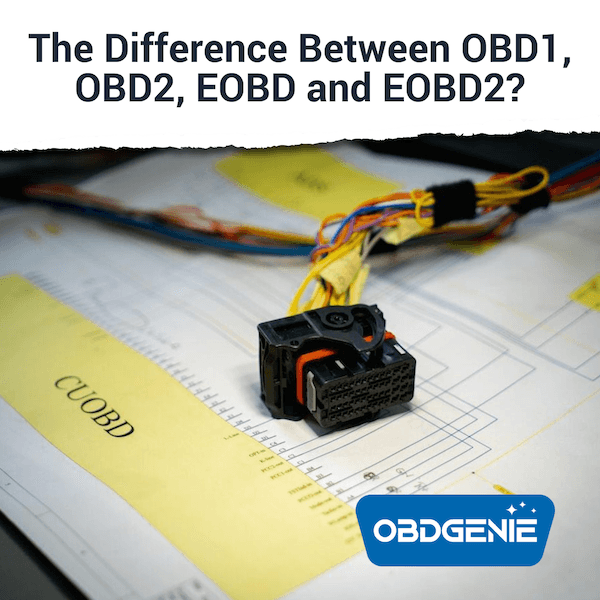
Oct 09 , 2023
What is difference between OBD1, OBD2, EOBD and EOBD2?
OBD stands for On-Board Diagnostics. It is a system that monitors and reports on the performance of a vehicle's engine and emission control systems. OBD systems were first introduced in the early 1990s, and they have become increasingly sophisticated over the years.
There are two main types of OBD systems: OBD1 and OBD2. OBD1 was the original system, and it was used on vehicles from the early 1990s to mid-1990s. OBD2 is the newer system, and it is used on all vehicles manufactured since 1996.
EOBD stands for European On-Board Diagnostics. It is the European equivalent of OBD2, and it is required on all vehicles sold in Europe since 2001. EOBD2 is the latest version of EOBD, and it is required on all new vehicles sold in Europe since 2014.
Differences Between OBD1 and OBD2
OBD1 and OBD2 are similar in many ways, but there are also some important differences. OBD1 systems are more basic and less comprehensive than OBD2 systems. OBD1 systems typically only monitor emission control systems, while OBD2 systems monitor a wide range of engine and emission control systems, as well as other systems such as the transmission, ABS, and airbags.
Another difference between OBD1 and OBD2 is the way that they communicate. OBD1 systems use a variety of different communication protocols, while OBD2 systems use a standardized protocol called CAN (Controller Area Network). This makes it easier to diagnose problems with OBD2 vehicles, as all OBD2 scanners use the same protocol.
Differences Between OBD2 and EOBD
OBD2 and EOBD are very similar systems, and the main difference is that EOBD is required on all vehicles sold in Europe, while OBD2 is required on all vehicles sold in the United States and other countries.
There are a few minor differences between OBD2 and EOBD, such as the specific emissions standards that they monitor. However, these differences are not significant, and an OBD2 scanner can be used to diagnose problems with EOBD vehicles.
Differences Between EOBD and EOBD2
EOBD2 is the latest version of EOBD, and it is required on all new vehicles sold in Europe since 2014. EOBD2 is more comprehensive than EOBD, and it monitors a wider range of emissions standards.
EOBD2 also includes a number of new features, such as the ability to detect and report on emissions problems that are not related to the engine or emission control systems.
Benefits of Using OBD Systems
OBD systems offer a number of benefits, including:
- Reduced emissions: OBD systems help to reduce emissions by monitoring and reporting on the performance of the vehicle's engine and emission control systems. This allows mechanics to identify and repair problems early on, before they cause emissions to increase.
- Improved fuel economy: OBD systems can also help to improve fuel economy by identifying and repairing problems that can cause the vehicle to waste fuel.
- Reduced maintenance costs: OBD systems can help to reduce maintenance costs by identifying and repairing problems early on, before they cause more serious damage.
- Improved performance: OBD systems can also help to improve the performance of the vehicle by identifying and repairing problems that can cause the vehicle to run poorly.
How to find out which OBD system my car has
The easiest way to find out which OBD system your car has is to look at the diagnostic connector. The OBD connector is a 16-pin connector that is usually located under the dashboard on the driver's side. If your car has a 16-pin connector, then it has OBD2 or EOBD. If your car has a different type of connector, then it has OBD1.
You can also check your car's owner's manual to find out which OBD system your car has.
How to Use an OBD Scanner
An OBD scanner is a tool that can be used to read and interpret OBD data. OBD scanners are available at most auto parts stores and online retailers.
To use an OBD scanner, simply plug it into the OBD port on your vehicle. The OBD port is typically located under the dashboard, near the steering wheel. Once the scanner is plugged in, turn on the ignition.
The scanner will then read the OBD data from the vehicle's computer and display it on the scanner's screen. The scanner may also display trouble codes, which are codes that indicate specific problems with the vehicle.
If you see any trouble codes, you can look them up in the vehicle's owner's manual or online to find out what they mean. Once you know what the trouble codes mean, you can take the vehicle to a mechanic to have the problems repaired.
ConclusionOBD systems are an important tool for monitoring and maintaining the performance of your vehicle. By using an OBD scanner, you can identify and repair problems early on, before they cause serious damage or emissions problems.
